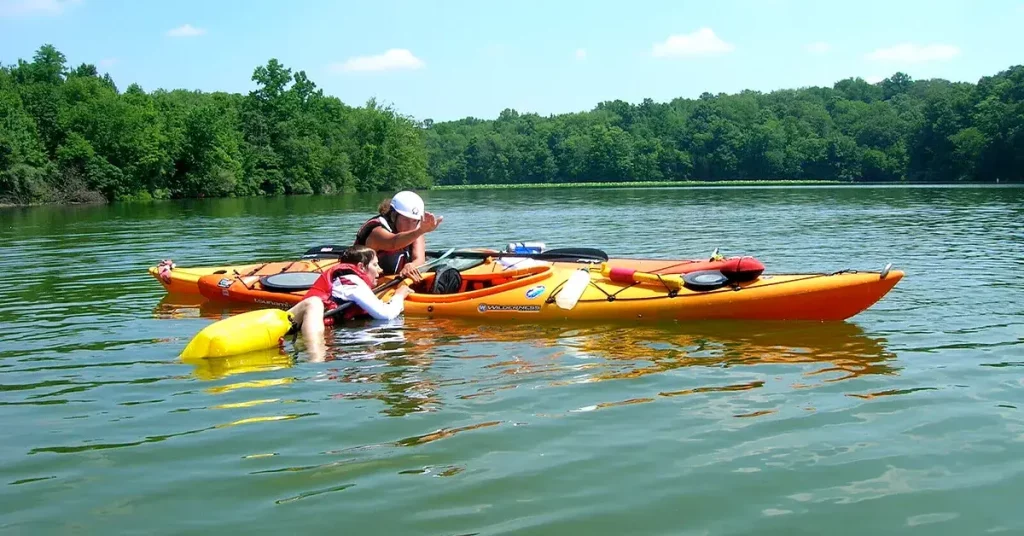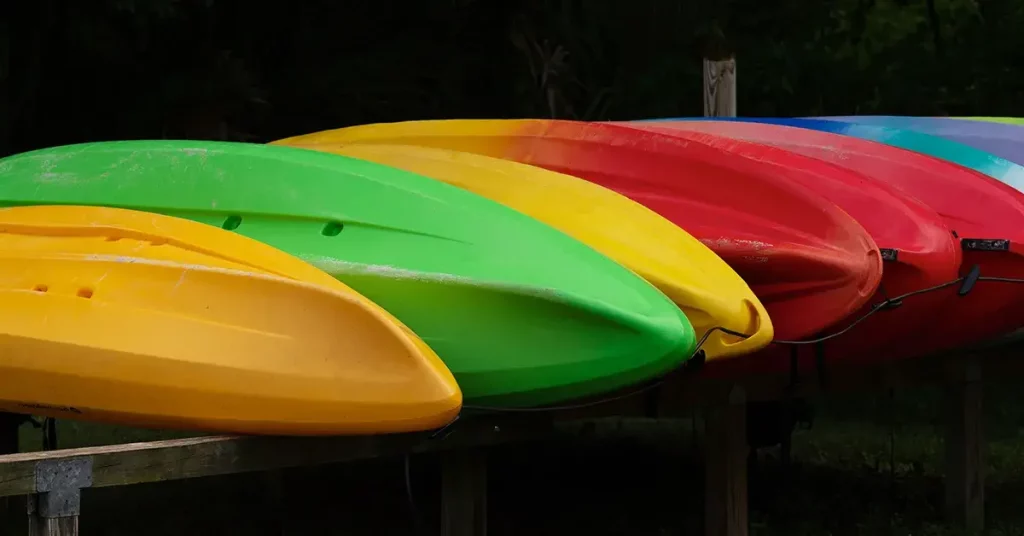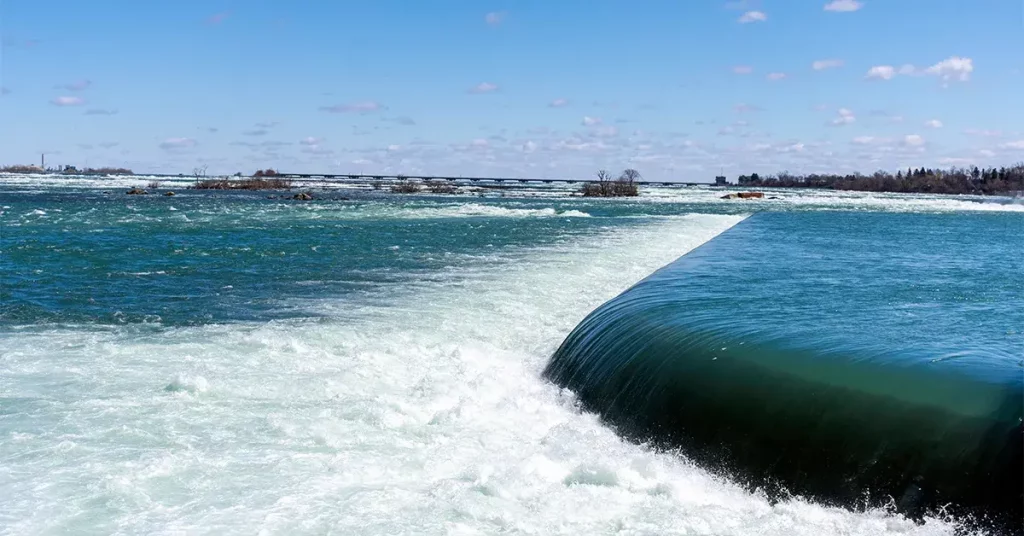One of the first self-rescue techniques many kayakers learn is the paddle float rescue. This technique uses a small paddle float attached to your paddle blade, creating a makeshift outrigger. Paddle floats are fairly straightforward pieces of safety gear.
They’re small inflatable or closed-cell flotation devices that can be stored nearly anywhere when deflated. They also has several other uses – like stabilizing your kayak in rough waters, acting as a makeshift cushion/headrest, and assisting during emergency rescues.
I’ll break down some of the best paddle floats on the market, explain how to use them effectively, and help you find the ideal floats for your needs.
Quick Answer: 5 Best Paddle Floats
Best Overall: NRS Sea Kayak Paddle Float
Runner Up: Riverstones Paddle Float
Best Foam Paddle Float: NRS Foam Paddle Float
Multi Use: North Water Four Play Kayak Paddle Float
Also Consider: Seattle Sports Dual-Chambered Paddle Float
How to use a kayak paddle float
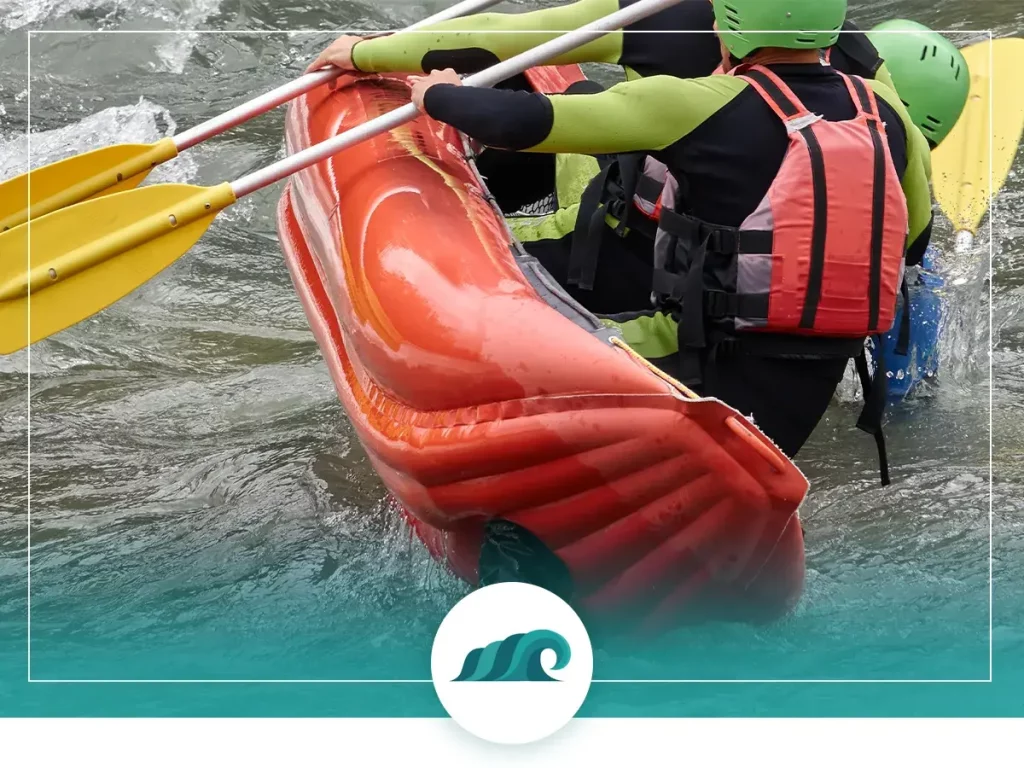
Before you pick out one or more paddle floats for your kayak, you’ll need to know how to use them effectively.
While there are several different techniques you ought to learn to perform a self-rescue, the paddle float rescue is one of the most effective and is the easiest for most beginners to perform. Keep in mind that when you’ll need to perform a paddle float rescue in real-life, you’ll need to inflate your float while you’re in the water. This can be tricky if you’ve never done it before, which is why you should practice, practice, practice.
Here’s how to perform a paddle float rescue, step-by-step:
- Wet exit your kayak into the water, using one hand to keep the kayak and paddle nearby.
- Pull out your paddle float, fully inflate it, and then attach the float to the end of your kayak paddle and cinch it in place.
- Place the paddle end without the float on your kayak’s deck, or hooked inside the cockpit. The other end should be extended away from your boat perpendicularly.
- Hoist your chest onto the deck using the paddle like an outrigger to support your weight. Kick with your feet to initiate the move.
- Once your upper body is firmly planted on the deck, swing one leg into the cockpit followed by the other. Keep one arm firmly planted on the paddle blade for stability throughout the move.
- When both legs are in the cockpit, slowly rotate your body until you’re facing forwards.
- Now pull your paddle in, remove the paddle float, and secure it inside the cockpit.
- If you’re performing a self-rescue in rougher waters, you’ll want to partially insert one of your legs into the kayak cockpit as you inflate the float. This will prevent your kayak from getting swept away by rolling waves.
Another thing to keep in mind is practicing this self-rescue maneuver in calm water is different from performing it in rougher weather. If possible, practice your paddle float rescue in the surf, as this will mimic capsizing in rougher weather.
Check out this video for a hands-on look at preforming the paddle float self-rescue:
Best Overall: NRS Sea Kayak Paddle Float
NRS makes some of the best kayaking gear on the planet – and this paddle float is no exception. It features a rock-solid durable nylon shell, with a 2” webbing grab loop for easy access during emergencies. Dual inflatable chambers provide built-in redundancy, so if one of the chambers fails, you’ll still be able to get back into your kayak.
Reflective tape on both sides of the float provides increased visibility, while built-in webbing and a barrel lock drawcord secure the float to your paddle. Each inflatable chamber displaces 7 liters, for a total of 14 liters when both chambers are inflated. You can use the paddle float with one chamber inflated or inflate both for maximum flotation.
Mesh material at the bottom of the float allows excess water to drain out if necessary. The float is big enough to fit nearly any sized kayak paddle, and also doubles as a camp pillow in a pinch!
Key Features
- Large main pocket easily slips over and secures to any sized paddle
- Durable nylon outer shell with 2” grab loop
- Dual air chamber provides redundant backup
- Reflective tape for increased visibility on the water
- AIDS IN RE-ENTRY: Paddle float designed to help stabilize your boat during an unassisted re-entry situation
- DURABLE DESIGN: Designed with a durable nylon outer shell with a 2-inch webbing grab loop
- DUAL-CHAMBERS: Dual-chamber air design with easy-to-use twist valves give you a backup chamber
- GREAT VISIBILITY: Has reflective tape on the sides for greater visibility
- 14 LITERS: Both chambers of the float displace 14 lit
Prices pulled from the Amazon Product Advertising API on:
Product prices and availability are accurate as of the date/time indicated and are subject to change. Any price and availability information displayed on [relevant Amazon Site(s), as applicable] at the time of purchase will apply to the purchase of this product.
View Pricing On
Runner Up: Riverstones Paddle Float
Featuring a similar design to the NRS paddle float above, this well-designed paddle float provides similar functionality at a reasonable price point. It features an outside mesh pocket rather than a slot in between the two inflated sections. This allows the paddle to remain functional while the float is deployed, so you’ll still be able to maneuver your craft in rough water.
Two separate air compartments with separate twist-operated air hoses allow you to fill the float to your preferred level. The design also makes practicing your roll with a little assist a breeze. The high-viz yellow color makes it easy to spot in an emergency, while the quick-release buckle makes securing the float to your paddle take mere seconds.
If you’re looking for a durable, functional paddle float without spending an arm and a leg then this one makes an excellent choice.
Key Features
- Exterior mesh pocket for rapid attachment to any paddle blade
- Two separate inflatable compartments with twist-operated hoses
- High-viz yellow color is easy to spot on the water
- Quick release buckle system
- This indispensible self rescue device has dual air chambers with twist air valves. Mesh paddle pocket with a quick release buckle closure to secure your paddle blade. High visibility yellow. Size: 12.5 x 24. Wt: 12.5
Prices pulled from the Amazon Product Advertising API on:
Product prices and availability are accurate as of the date/time indicated and are subject to change. Any price and availability information displayed on [relevant Amazon Site(s), as applicable] at the time of purchase will apply to the purchase of this product.
Best Foam Paddle Float: NRS Foam Paddle Float
Foam floats make an excellent alternative to inflatables – especially if rapid deployment is what you’re after. Because there’s no air bladder to inflate, you can attach them to your paddle blade more rapidly, and get back in your kayak faster.
The float is made from a bright-orange 400-denier nylon outer shell, with strips of reflective tape that provide excellent visibility in low light. This also makes it useful as a signaling method in low-visibility. Measuring 18” x 8.5” x 3”, and made from solid foam, it will take up more space inside your kayak than similarly sized inflatable floats.
The EPE foam material is tough as nails, won’t absorb water, and can stand up to years of abuse. It also doubles as a makeshift seat cushion or backrest, so you won’t need to sacrifice precious cargo space inside your kayak.
Key Features
- Makes a great alternative to inflatable floats – especially for quick deployment
- EPE foam material is highly durable and won’t absorb water
- Bright orange 400-denier nylon outer shell
- Doubles as makeshift seat or backrest
- 400D nylon outer shell
- EPE closed-cell foam
- Nylon fabric pocket for paddle blade
- Reflective tape
- 18 in L x 8.8 in W x 3 i
Prices pulled from the Amazon Product Advertising API on:
Product prices and availability are accurate as of the date/time indicated and are subject to change. Any price and availability information displayed on [relevant Amazon Site(s), as applicable] at the time of purchase will apply to the purchase of this product.
View Pricing On
Multi-Use: North Water Four Play Kayak Paddle Float
While it costs a bit more than other paddle floats, this multi-use paddle float provides several different uses including a beaching pad, sleeping pad, camp chair, and as a loading pad for your vehicle. The padded nylon surface with nylon webbing and buckles is designed to handle heavy-duty use around sand, rocks, gravel, and barnacles.
Two paddle blade pockets – one on each end – allow you to insert your paddle in a hurry. It’s significantly larger than most other paddle floats, so if you’re trying to conserve space in your boat you’ll want to look elsewhere.
When you’re using it as a skid pad for beaching or car loading, it will protect your kayak and vehicle from accidental damage. As a camp chair, it provides a decent level of back support, although not as much as a dedicated camp chair would.
Like the other foam paddle float reviewed above, it’s quick and easy to deploy in the water, as nothing needs to be inflated.
Key Features
- Multi-use paddle float works well as a float, beaching pad, sleeping pad, and camp chair
- Durable nylon surface can withstand dragging over rocks, gravel, and barnacles
- Larger than most paddle floats
- Fast deployment in the water
- Padded nylon surface with nylon webbing and buckles
- Originally designed to be used as a Kayak Beaching Pad to protect your boat from barnacles and rocks
- Multiple uses: double-ended paddle float, kayak beaching mat
- Vehicle protection pad for loading & unloading your kayak
- Portable camp chair, sleeping pad and kneeling
Prices pulled from the Amazon Product Advertising API on:
Product prices and availability are accurate as of the date/time indicated and are subject to change. Any price and availability information displayed on [relevant Amazon Site(s), as applicable] at the time of purchase will apply to the purchase of this product.
View Pricing On
Safety Kit: NRS Basic Touring Safety Kit
The NRS basic touring safety kit contains everything you might need to bail yourself out of trouble on the water. Along with NRS’s excellent paddle float, it comes with a bilge pump and sponge for removing water along with Fox 40 emergency whistle.
The paddle float is the same excellent model review above, with dual inflatable chambers to provide a high degree of flotation.
The whistle features a pea-less design that’s ideal for water environments and has a cushioned mouth grip and breakaway lanyard. The bilge pump is heavy-duty and able to move 8 gallons of water per minute to dry your boat in a hurry. It comes with an included foam float in case you drop it overboard.
The sponge will absorb every last drop of water, so you won’t have to deal with that last bit of water sloshing around in the hull.
Key Features
- Essential safety kit for any kayak
- Kit includes bilge pump, sponge, emergency whistle, and paddle float
- Heavy-duty bilge pump can move up to 8 gallons of water per minute
- Foam float attached to the pump provides flotation
- SAFETY KIT: The NRS Basic Touring Safety Kit gives you four items that you shouldnt boat without - a whistle, paddle float, bilge pump, and boat sponge
- LOUD WHISTLE: The Fox 40 Epik Whistle is a pea-less design that is ideal for water environments; Its loud, has a cushioned mouth grip, and a breakaway lanyard.
- PADDLE FLOAT: The NRS Paddle Float is the best on the market; You only need to inflate one chamber when you need to rescue yourself; a second chamber was added for safety and dependability (Each chamber displaces 7 liters - almost 2 gallons)
- BILGE PUMP: The NRS Bilge Pump is a heavy-duty pump, moving 8 gallons a minute to dry your boat out in a hurry
- BOAT SPONGE: The Deluxe Boat Sponge takes out the last bit of moisture and the sand and silt that the Bilge Pump doesnt re
Prices pulled from the Amazon Product Advertising API on:
Product prices and availability are accurate as of the date/time indicated and are subject to change. Any price and availability information displayed on [relevant Amazon Site(s), as applicable] at the time of purchase will apply to the purchase of this product.
Also Consider: Seattle Sports Dual-Chambered Paddle Float
Another well-made dual-chamber inflatable paddle float – this float will make re-entry to a capsized kayak a breeze. Quick-release buckles make rapid attachment and detachment and clip-on safety tether gives you peace of mind knowing your float isn’t going anywhere in choppy conditions.
High-viz reflective bindings make the float easy to spot on the water – so it’ll work as a makeshift signaling device. The dual bladders are easy to fill with the inflation tubes, and when not in use the entire things rolls up to the size of a small sock.
The material is rugged and nearly indestructible, so you’ll have no issue using the float as a makeshift float bag or pillow. Measuring 17” x 11.5”, it’s on the larger side, so you’ll have no problem with larger paddle blades or paddlers!
Key Features
- Large capacity dual-chambered paddle float
- Quick-release buckles allow for rapid attachment/detachment
- Built in safety-tether keeps the float from drifting away
- High-viz reflective bindings make the float easy to spot
- ESSENTIAL - A Vital Self-Rescue Device for Kayakers
- BUOYANT - Extra Large Capacity for Maximum Buoyancy
- SAFETY - Reflective Binding for Visibility and Clip On Safety Tether to Eliminate Loss in Wind
- SELF RESCUE - Allows Emergency Kayak Re-Entry Easier in the Event it is Overtur
Prices pulled from the Amazon Product Advertising API on:
Product prices and availability are accurate as of the date/time indicated and are subject to change. Any price and availability information displayed on [relevant Amazon Site(s), as applicable] at the time of purchase will apply to the purchase of this product.
How to pick the right kayak paddle float?
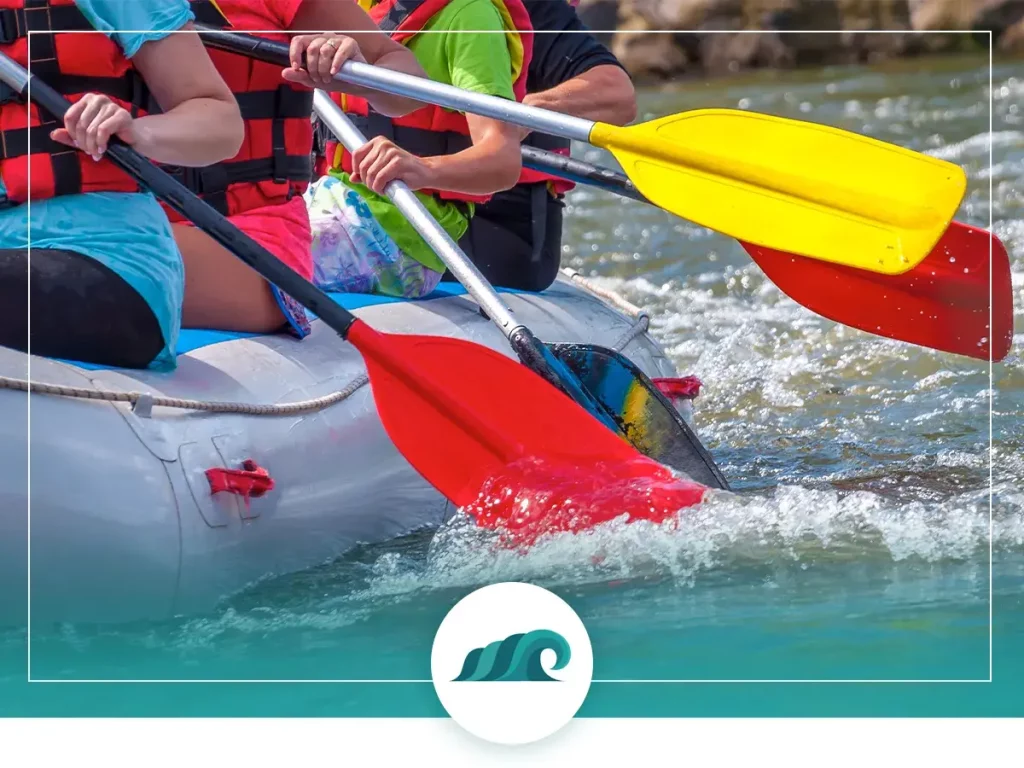
While picking the right kayak paddle float isn’t that much of a challenge – there are a few important factors to keep in mind. Let’s take a look at these in detail.
Inflatable vs. Foam
The most important consideration when picking out a kayak paddle float is whether you want an inflatable or closed-cell foam model. Both have their relative strengths and weaknesses, so there isn’t one best option for everyone.
Inflatable paddle floats are compact, easy to stow near anywhere when deflated and work well as makeshift camping pillows or cushions. Unless you store them when they’re fully inflated, they’ll need to be inflated once you’re already in the water. This adds additional time to preforming a self-rescue and can make the maneuver more difficult to perform.
Foam inflatables are made from solid pieces of closed-cell foam – making them fast and easy to deploy in the water. On the other hand, they’ll take up more space inside your kayak, which can be at a premium in small-sized watercraft. Many people will use them as a makeshift kayak seat cushion/backrest, so you won’t need to sacrifice valuable real estate inside your kayak.
So, which type should you go for?
This will largely depend on personal preference but also depends on your skill level and kayaking environment.
If you’re more experienced and comfortable performing a paddle float rescue, then an inflatable makes sense. You’ll need to inflate it while your chest-deep in water, but once you’ve practiced this a few times it’s not that difficult.
If you’re less experienced and haven’t had much practice preforming a paddle float rescue, then a foam float is a good option.
Also, consider the water conditions you paddle in. If you frequently find yourself kayaking in heavy chop, wind, and surf, then a closed-cell foam float is a strong choice. Clutching your capsized kayak and paddle in one hand as you struggle to inflate a float with the other – while being jostled around by 5-foot waves – is no one’s idea of a good time.

